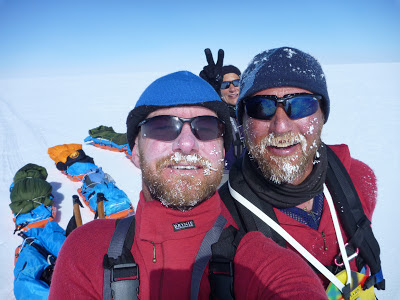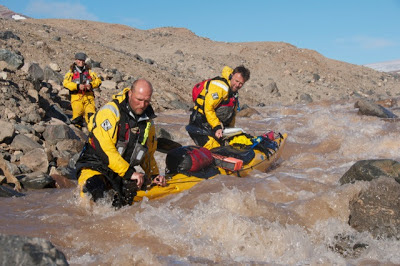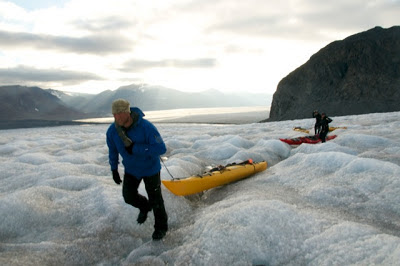Guest Post: Brynje Mesh base layers – The Best base layer for Kayacking?
By Petter Thorsen: Polar Guide, Arctic Training Instructor and former Norwegian Special forces soldier
Merino wool VS Super Thermo
Like most Norwegian outdoor enthusiasts, I have been a wool-freak all my life. The traditions of using natural fabrics are of even greater value in the "plastic" world we are living in today. In addition to being environmentally friendly, I like the way it keeps some of its warming abilities even if it gets wet. So the merino-wool revolution we`ve been experiencing the past 6-7 years is a great thing. But even though I’m a big fan of wool, I must admit I have discovered a baselayer that works much better! Brynje Super Thermo is the best temperature-regulating baselayer on the market…….in my opinion.
Compared to other synthetic fabrics -and even to wool - the Brynje Super Thermo mesh soaks up less water, dries much faster, breathes better and feels (and in fact is...!) much drier and warmer.
Almost every polar explorer has discovered the benefits of using Brynje mesh on their expeditions. Hour after hour of hard work in extremely low temperatures is broken up by short pit-stops (snacking pauses of 5-10 min). The stops are critical because it`s here you are able to get the fuel your body needs, get some minutes of rest and recovery, and perhaps do small repairs or adjustments. Pauses are needed to be able to keep up the average speed throughout the day (and day after day). On expeditions like these, it’s all about going as fast as possible while saving as much energy as you can along the way.
The more energy your body expends in either heating up, cooling down or even drying your clothing, the less energy is left for recovery - and speed.
 |
|
Courtesy of Petter Thorsen: Crossing Greenland on Skis. |
Brynje clothing is vital in the above scenario, but works even better in wet conditions.
I still remember a 4 day canoe trip last autumn where I forgot my Brynje Super Thermo. Day one was sunny and nice. But the next 3 days had heavy rain and the Gore-Tex had no chance of keeping water out. Soaking wet to my skin I really missed the Super Thermo. When my soaking wet merino baselayer was sticking to my skin, sucking heat from my body, I could have kicked myself for leaving the Super Thermo behind. Less wet material in contact with your skin means more comfort and less energy lost. It`s simply the most comfortable baselayer to be soaking wet in. I`ll never leave home without it again.
Brynje Super Thermo works very well in cold, wet and changing conditions. Even when waiting for my kids at the football training field on a cold and drizzly day, it`s the best way to stay comfortable.
That`s why I am surprised that sea and white water kayakers have not yet discovered Brynje Super Thermo! Gore-tex (or similar) kayaking dry-suits or jackets/pants do breath quite well but only to a certain degree. Climbing into your dry-suit with latex gasket and watertight zippers, you are not able to ventilate your clothing as you can in your skiing jacket and pants. Add a spray-skirt and a lifejacket on top of that, and put yourself into the kayaks cockpit...it will be humid in there... and then when you stop, you get cold immediately (not to mention when you finished kayaking for the day and climb out of your suit with a wet baselayer!)
 |
| Courtesy of Petter Thorsen: Kayaking around Spitzbergen |
I was one of four people on a 550K / 20 days sea kayak expedition around the northwest corner of Spitzbergen in 2011. Three of us used Brynje Super Thermo and one did not... Three of us had the same first layer on 24/7 throughout the expedition. The guy with normal synthetic and merino baselayer was freezing in the breaks and when we landed our kayaks for the day (before the tent was up and the stove was going). He had to change, dry and struggle with the clothing - every day. It was easy to see that this took a lot of energy from him that could have been spent elsewhere.
The best thing to wear under your dry-suit is Brynje Super Thermo next to your skin. In normal temperatures this will be enough. In colder temperatures (closer to 0 C), you will need something on top of that – either a synthetic or merino baselayer of the thickness you prefer. Most important is that the second layer also "breathes" quite well (it doesn`t trap the moisture but allows the membrane in the dry-suit to breathe better. My preference is wool on top of the Super Thermo, and I have two reasons for this: first - the strength of the fibers, and second - the safety factor you get when working with campfire or a hot stove (synthetic shirts will melt!). BrynjeArctic Double or even Arctic XC-suit is a very good option in cold conditions.
 |
| Courtesy of Petter Thorsen: Negotiating freezing Glacial rivers in Spitzbergen |
At the end of your day, or towards a lunch-break (if the conditions allows you to), you should cool down by slowing your paddling the last 10 minutes before you go onshore. This will allow your dry-suit to breath out most of the humidity inside. Once you’ve finished paddling, pull down the top of your dry-suit, ventilate for 30 seconds. Then have a nice warm fleece or a thin down/synthetic jacket (which should be easy to access) to put on. No need to change/take off the baselayer (not until you reached home 3 weeks later...).
 |
| Courtesy of Petter Thorsen: Hauling up and over the glacier. |
Not yet convinced that Super Thermo works better than Merino?
Buy a Super Thermo T-shirt and use it under your usual baselayer or cycling shirt. The next thing you will do is to get yourself a Super Thermoshirt!
I like the 3/4 Zip polo best because it gives a lot of options for heat regulation with the higher neck and long zipper.
Happy paddling!







